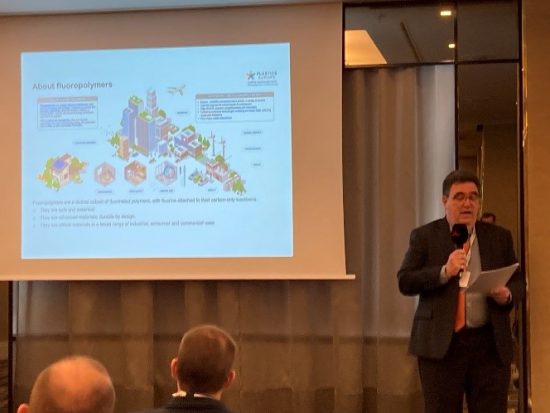During our AGM meeting in Prague on April 23, Mr. Nicolas Robin, Director Fluoropolymers Products Group at PlasticsEurope, gave an insightful presentation on the current situation on Fluoropolymers and the PFAS REACH restriction timeline.
Summary:
- Responsibility across life-cycle of fluoropolymers starts with us. Fluoropolymer manufacturers in Europe commit to the highest industry standards for manufacturing worldwide. Fluoropolymers can be safely and sustainably managed at end of life.
- During the REACH restriction process, alternatives must be fully scrutinised and assessed for their risks to human health and the environment, their technical and economic feasibility, as well as their availability on the market.
- Fluoropolymers are safe and essential, playing a critical role in the European innovation and competitiveness of the EU industry.
- Fluoropolymers do not pose a risk to human health or the environment as they are non-toxic, not bioavailable, non-water soluble, non-mobile, and do not bio-accumulate.
PFAS restriction update from FPP4EU
FPP4EU, a sector group of CEFIC, has set up a Collaboration Platform on varied applications and uses of PFAS and presented Best Practices around the globe on PFAS: a global & industry perspective on April 18 and 19, 2024.
Stakeholders from the United Kingdom, the United States of America, Canada, and China explained the regulations on PFAS restrictions in their countries.
More information can be found on the FPP4EU website.
PFAS restriction update from European Chemicals Agency (ECHA)
During the public consultation on the PFAS restriction dossier submitted by the five national authorities, which ran from March to September 2023, a record number of 5642 comments were received.
These comments contained extensive information on the uses of PFAS across the EU and European Economic Area (EEA), as well as information on the suitability of alternatives and the socio-economic impacts of the proposed restriction. It is very important that these comments and the supporting information provided are considered carefully to ensure that any future regulation of PFASs is based on the best available information. Given the high number of comments received, updating the assessments takes time, particularly for the uses of PFAS that received the most comments.
The Agency’s scientific committees for Risk Assessment (RAC) and for analysis (SEAC) will evaluate the proposed restriction together with the comments from the consultation in batches, focusing on the different sectors that may be affected.
In tandem, the five national authorities who prepared the proposal, are updating their initial report to address the consultation comments. This updated report or “background document” will be assessed by the committees and will serve as the foundation for their opinions.
The sectors and elements discussed in the three committee meetings are:
- March 2024 Meetings: Focus on consumer mixtures, cosmetics, ski wax, PFAS hazards (RAC), and general approach (SEAC).
- June 2024 Meetings: Emphasis on metal plating, manufacture of metal products, and further discussion on hazards (RAC).
- September 2024 Meetings: Examination of textiles, upholstery, leather, apparel, carpets (TULAC), food contact materials, packaging, petroleum, and mining.
The SEAC draft opinion will be published after the last sector has been completed in September 2024. The RAC will then publish its opinion, and the SEAC will publish its draft opinion, which is the basis for the 2-month consultation on socio-economic impacts.
More information about the committees’ plans to evaluate the remaining sectors and about the next procedural steps will be announced as work advances. This information will be communicated in conjunction with the committee meetings.
As soon as the ECHA committees have finalised their opinions, the European Commission will decide on the restriction together with the EU Member States.
